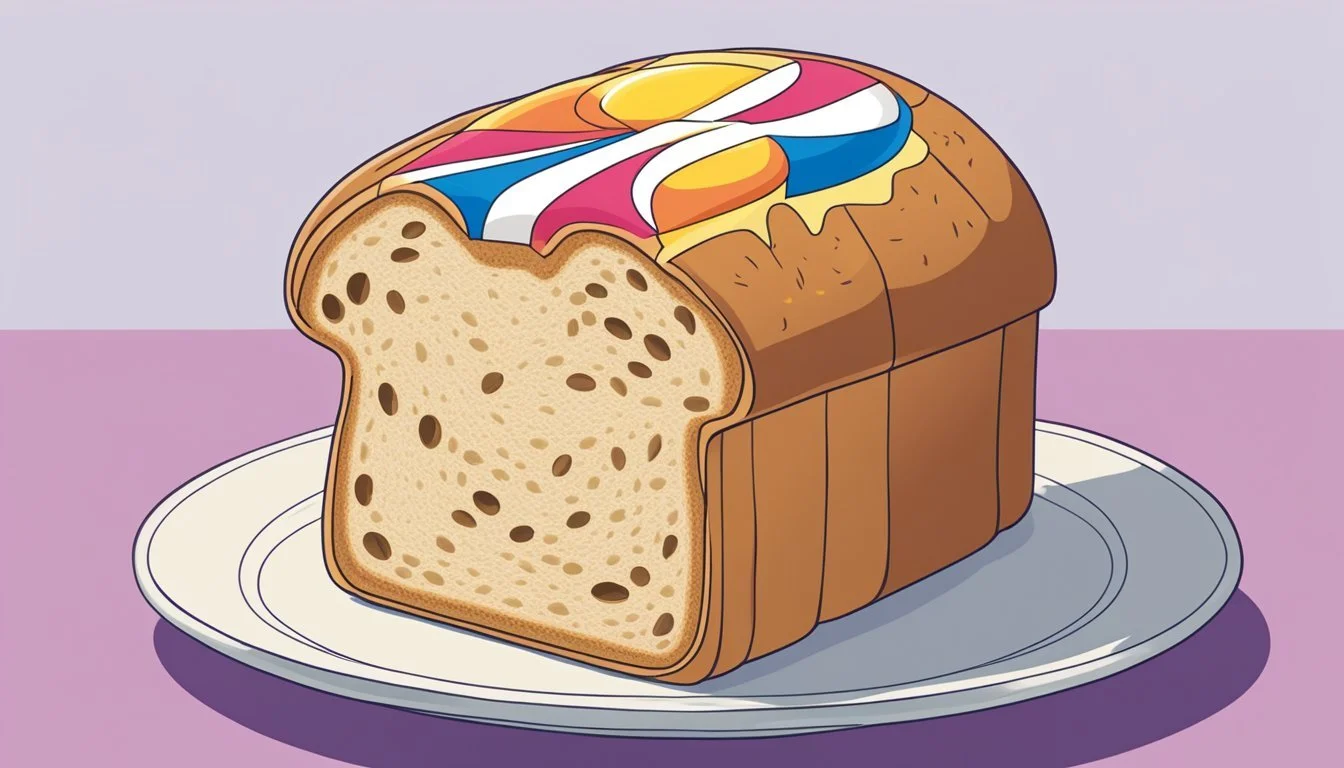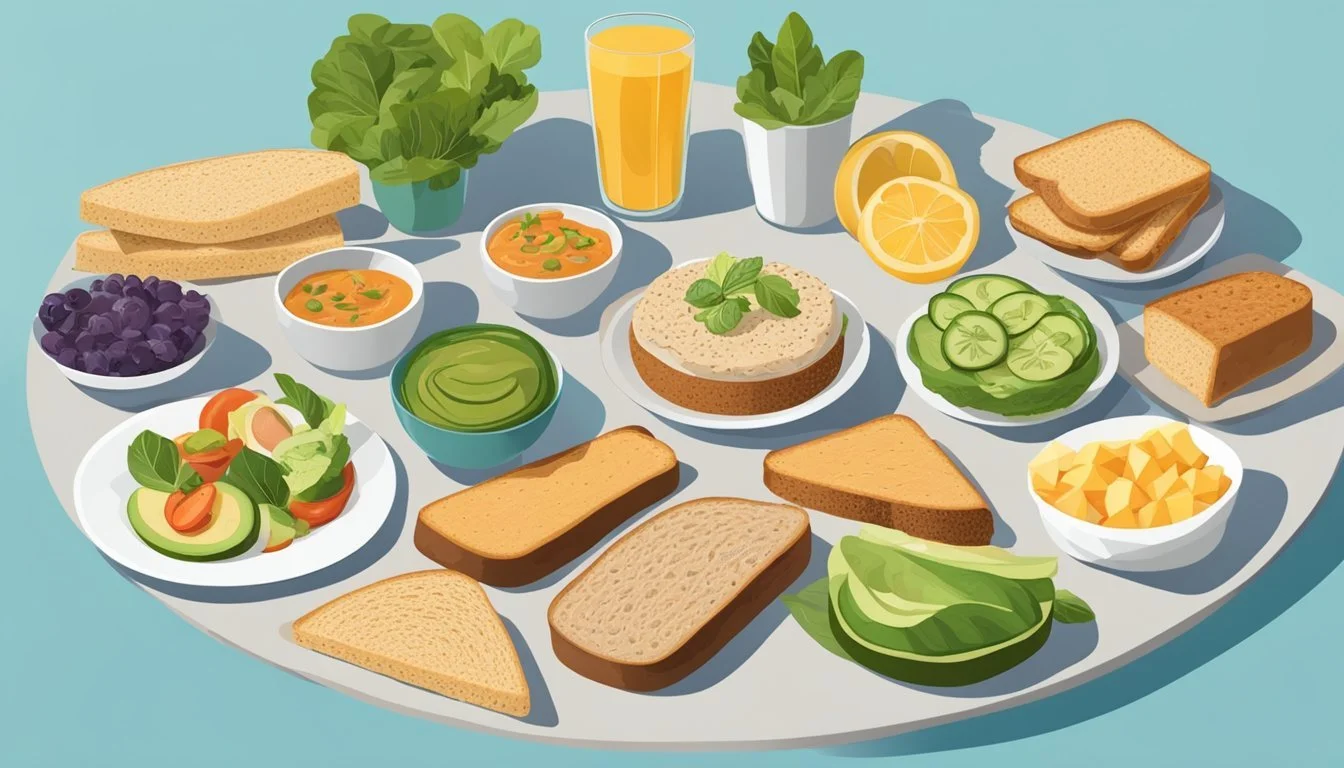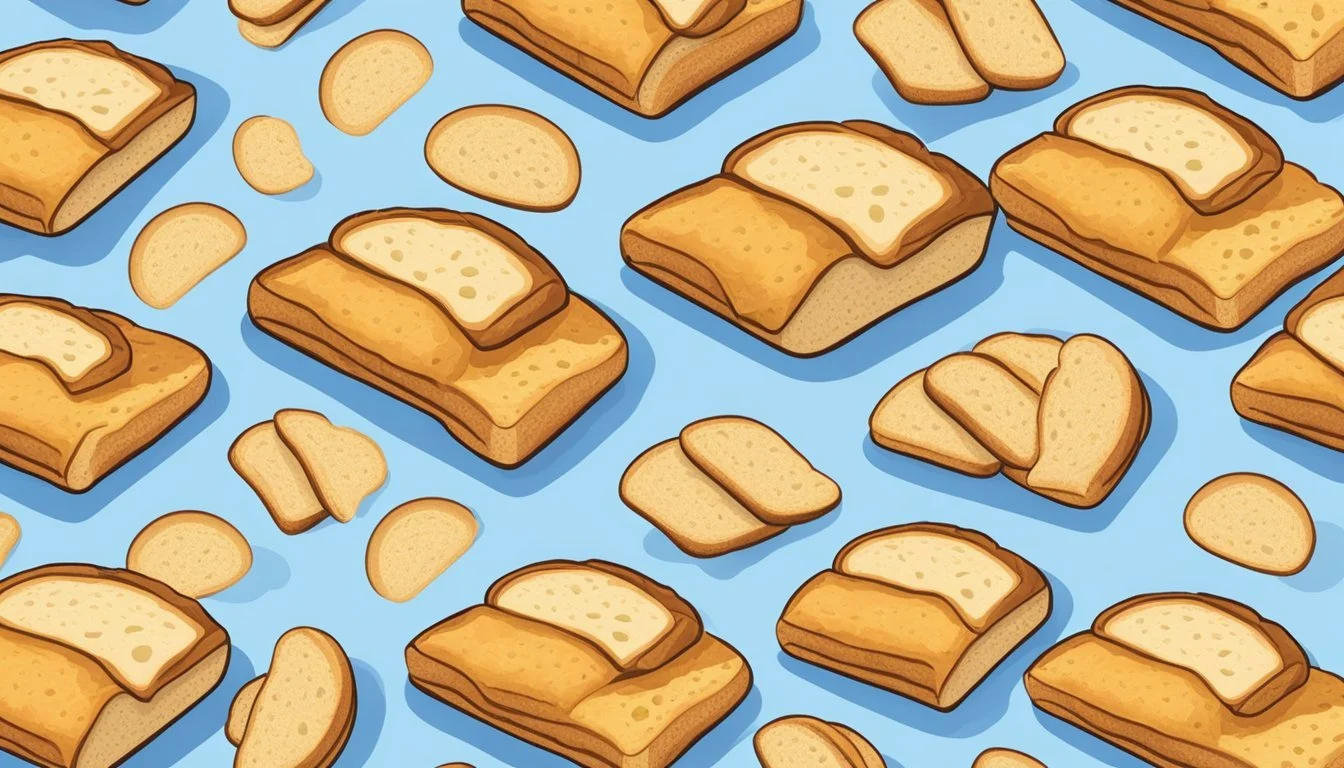How Many Slices of Wonder Bread Per Day is Too Much?
Understanding Healthy Consumption Limits
Understanding the appropriate quantity of bread one can consume daily without negative health effects is important in dietary planning. Bread, a staple food in many diets around the world, is often a primary source of grains. White bread, such as Wonder Bread, is particularly popular but comes with considerations due to its refined grain content and added sugars. The U.S. Department of Agriculture (USDA) guidelines suggest that grain servings per day can vary based on age, sex, and activity levels.
Dietary guidelines provide a general framework that indicates moderately active women aged 19 to 50 should aim for six servings of grains daily, while men aged 19 to 30 may require up to eight servings. A single serving of bread is typically considered one slice, but with different types of bread containing varying nutrient levels, the number of slices that equate to a serving may change. In the case of white bread like Wonder Bread, it is important to consider not only the serving size but also the nutritional content, as it may contain added sugars and lack the fiber found in whole grain alternatives.
For those concerned about carbohydrate intake, whole grains are often recommended over white, refined breads. When making choices about bread consumption, it is crucial to balance intake with individual dietary needs, keeping in mind that total grain requirements per day include all grain products, not just bread. Hence, determining the right amount of bread, particularly types like Wonder Bread, depends on personal dietary restrictions, nutritional goals, and the overall balance of one's diet.
What Is Wonder Bread?
Wonder Bread is a brand of sliced white bread known for its soft texture and accessibility, making it a staple in many American households.
History and Production
Wonder Bread was introduced in the United States in the early 20th century and has since become a symbol of classic American bread. The bread undergoes a process typical of commercial white bread production, involving the mixing of ingredients, dough conditioning, rising, and baking in large-scale facilities. Its production has evolved over the years to become more efficient, responding to the growing demand for convenience.
Ingredients and Nutrition Profile
The primary ingredients of Wonder Bread consist of refined wheat flour, water, yeast, and some form of sweetener, which contributes to its carbohydrate content. It usually contains added vitamins and calcium to improve its nutritional profile, making it fortified compared to regular white bread. Wonder Bread notably includes:
Calcium Carbonate: Up to 30% of the RDA of calcium per two slices.
Vitamins: A good source of Folate per serving.
Carbohydrates: Approximately 140 calories and 29 grams of carbohydrates per serving, which is two slices.
Sodium: 100 mg of sodium per slice, bearing in mind the FDA's recommended maximum sodium intake for an average healthy adult is 1500 mg per day.
Preservatives and Dough Conditioners: Such as sodium stearoyl lactylate, which helps maintain freshness and texture.
Sugar: Present in the form of added sweeteners, contributing to the overall calorie content.
Fiber: Generally lower in fiber compared to whole-grain bread options.
Gluten: Present, as it is made from wheat, making it unsuitable for individuals with gluten intolerance or celiac disease.
By providing essential nutrients such as calcium and folate, Wonder Bread contributes to meeting daily nutritional needs, while also reflecting considerations related to sugar and sodium content.
Nutritional Guidelines
When determining how many slices of Wonder Bread or any white bread one should consume daily, it is critical to consider established nutritional guidelines and the role that bread serves within a balanced diet.
Daily Recommended Intake
The Dietary Guidelines for Americans recommend that grains, including bread, should compose a part of the daily diet. For example, moderately active adults generally require about 6-8 ounces of grain foods per day, depending on age and sex, where 1 slice of bread is equivalent to 1 ounce.
Women aged 19-50 should consume approximately 6 ounces of grains.
Men aged 19-30 need about 8 ounces of grains.
Children have lower requirements, typically 4-6 ounces, depending on their age and activity level.
Grains are broadly categorized into whole grains and refined grains. Whole grains, such as whole-wheat bread, brown rice, and quinoa, are preferable due to their higher content of fiber and essential nutrients. The fiber content in whole grains plays a vital role in maintaining digestive health and may help prevent chronic diseases.
Role in a Balanced Diet
Bread, particularly Wonder Bread, is part of the grain foods group. While it is a source of carbohydrates that provides energy, it is essential to opt for whole-grain or enriched options which are more nutrient-rich compared to their non-enriched counterparts.
Nutrition experts recommend diversifying the types of grain foods consumed. Including a variety of grains like rice, cereals, and quinoa ensures a diet rich in fiber, minerals, and other essential nutrients. The Australian Dietary Guidelines and nutritionists suggest that nutrient-rich foods should contribute to most of one's caloric intake for a healthy diet.
When evaluating Wonder Bread, which is a type of refined grain, one should be cautious. Consuming bread with little to no fiber and a high amount of added sugars can lead to consuming too many empty calories. Dietitians often encourage including bread that is high in protein, bran, and other nutrients over less beneficial variants.
Health Considerations
When assessing the impact of Wonder Bread consumption on health, it is crucial to consider its effects on diet and weight management, blood sugar control, and the implications for those with gluten-related disorders.
Diet and Weight Management
Individuals aiming for weight loss or maintaining a healthy weight should monitor their intake of Wonder Bread. Two slices of Wonder Bread contain approximately 140 calories and 29 grams of carbohydrates. Regular consumption without adequate physical activity can contribute to weight gain, as excess calories are stored as fat. Additionally, it's important to balance bread intake with other nutrients to maintain optimal cholesterol levels.
Blood Sugar and Diabetes
For those managing blood sugar levels or living with type 2 diabetes, monitoring carbohydrate intake from sources such as white bread is vital. The refined flour in Wonder Bread can cause quick spikes in blood sugar levels. Integrate whole grains and fiber-rich options when possible to maintain a balanced blood sugar level and reduce the risk of diabetes-related health concerns.
Gluten-Related Disorders
For individuals with celiac disease, an autoimmune disorder, consuming Wonder Bread which contains gluten can damage the small intestine. Those with non-celiac gluten intolerance or irritable bowel syndrome (IBS) may also experience discomfort and adverse symptoms. For these individuals, consumption of Wonder Bread should be avoided, and gluten-free alternatives should be considered.
Bread Consumption
Determining an appropriate amount of bread intake requires understanding portion sizes and assessing individual dietary needs. The consumption of bread, specifically Wonder Bread, must be evaluated in the context of nutrition and the potential for weight gain.
Understanding Portion Sizes
For a healthy adult, portion sizes of bread generally translate to the number of slices consumed. According to dietary guidelines, a single serving of grains, such as a slice of bread, is typically 1 ounce. For Wonder Bread, two slices are considered one serving, equating to approximately 140 calories, depending on the specific product variation.
The U.S. Department of Agriculture (USDA) recommends that grain intake should be proportioned as follows, differentiating by age and sex:
Moderately active women aged 19 to 50: 6 servings (6 slices of bread) per day.
Women over 50: 5 servings (5 slices of bread) per day.
Moderately active men aged 19 to 30: 8 servings (8 slices of bread) per day.
Men aged 31 and above: 6 to 7 servings (6 to 7 slices of bread) per day.
Assessing Individual Needs
Individual dietary needs can vary based on a person's age, sex, level of physical activity, and nutritional goals. For instance, an individual who is more physically active may require more calories and, therefore, can consume more bread without adverse health effects. Conversely, someone with a sedentary lifestyle may need fewer servings to maintain a healthy weight.
When considering bread consumption, particularly Wonder Bread which contains added sugars and sodium, one must also take into account their overall daily intake and nutritional balance. A diet high in refined grains like white bread can contribute to weight gain if not appropriately balanced with physical activity and other dietary components.
In summary, while it is crucial to consider recommended servings and individual needs, one should also focus on the quality of the bread consumed. Whole grain options are generally healthier than white bread, offering more nutritional benefits and fiber, which may affect how much bread can be included in a balanced diet.
Alternatives to Wonder Bread
When aiming for a healthier diet or reducing white bread intake, exploring diverse bread and non-bread alternatives that offer superior nutritional value is essential.
Healthier Bread Choices
For those looking to substitute Wonder Bread, whole-grain bread stands out as a nutritious option. It retains all parts of the grain, including the bran, germ, and endosperm, contributing to a higher fiber content and essential nutrients. Whole-wheat bread is similar, but specifically made from whole wheat grains, offering more fiber than Wonder Bread. Sourdough bread is another choice, often easier to digest due to its unique fermentation process that also adds a distinct tangy flavor. Bread enthusiasts might also appreciate rye bread for its dense texture and gluten-free bread for those with gluten sensitivities, which can be made from a variety of grains like oats, brown rice, or barley. Many of these healthier bread alternatives include a mix of seeds and nuts, which add additional nutrients and textures.
Non-Bread Alternatives
For those looking to reduce their bread consumption altogether, there are numerous non-bread alternatives rich in complex carbohydrates and fiber. A bowl of oats with fruit can serve as a fulfilling breakfast, while brown rice or potatoes can complement a lunch or dinner meal. For salads, adding a variety of nuts and seeds like sunflower seeds or slivered almonds boosts the nutritional profile with healthy fats and protein. Pasta made from whole grains or legumes provides a satisfying base for a variety of dishes. Additionally, grains such as barley and rye can be used in place of rice or made into pilafs, enriching meals with their chewy textures and nutty flavors. Those opting for sandwiches can use large lettuce leaves or collard greens in place of bread to wrap their favorite fillings in a crisp and refreshing package.
Eating Bread with Health Conditions
When considering bread consumption, especially products such as Wonder Bread, individuals with health conditions should take into account the potential impact on heart and digestive health.
Heart Health
Consuming Wonder Bread in moderation is key for those concerned with heart health. Wonder Bread contains sodium, which in excessive amounts can lead to high blood pressure, a risk factor for heart disease. Two slices of Classic White Wonder Bread contain 180 milligrams of sodium, so it's important to monitor intake. Moreover, those with heart health concerns should prioritize breads that are rich in whole grains and fiber. Studies in meta-analyses suggest that whole grains may support heart health more effectively than refined grains due to their comprehensive nutritional profile.
Digestive Health
For individuals focused on digestive and gut health, the type of bread they consume can have a significant impact. Wonder Bread, being a refined grain product, generally offers less fiber than its whole grain counterparts. Fiber plays a crucial role in maintaining digestive health, possibly reducing the risk of conditions like colorectal cancer. Those who have gluten sensitivity or celiac disease also need to consider their bread choices carefully, as Wonder Bread contains gluten, which can aggravate these conditions. Selecting gluten-free or higher fiber bread options may benefit those concerned with digestion-related issues.
Bread in Different Diets
In considering how bread fits into various diets, one must evaluate the type of diet and the role of bread within it. Bread's nutritional content and how it affects diet goals like weight management or allergy accommodation can vary significantly.
Weight Loss Diets
For individuals following a weight loss diet, the focus often shifts towards bread that is lower in calories and has a lower glycemic index (GI). Whole grain bread is frequently recommended because it is more nutrient-dense and has a lower GI, helping to keep blood sugar levels stable. This can aid in satiety and potentially reduce overall calorie intake.
Wonder Bread, as a refined grain option, may not be the best choice for these diets. It typically has a higher glycemic index compared to whole grain alternatives and may contribute to quicker energy spikes and crashes, which can be counterproductive in weight management. When considering portion sizes, individuals aiming for weight loss may limit their intake to avoid excess calories.
Gluten-Free and Other Restrictive Diets
Those on gluten-free diets must avoid traditional wheat bread due to gluten sensitivity or celiac disease. Gluten-free bread is made from a variety of alternative flours, such as rice, almond, or coconut flours. When evaluating the healthiness of gluten-free bread, it's essential to assess the specific ingredients used, as some gluten-free options can be high in sugar and calories.
Other restrictive diets might also limit the consumption of bread. For instance, a low-carb diet may require an individual to select bread options that have reduced carbohydrate content. These individuals might opt for thinner slices or specifically formulated low-carb bread.
In both cases, reading labels and understanding nutritional content are crucial for maintaining compliance with dietary restrictions while meeting nutritional needs.
Frequently Asked Questions
What is a safe quantity of Wonder Bread to consume daily?
Adults typically can consume 2-4 slices of Wonder Bread per day. However, one should adjust their intake based on individual dietary needs and activity levels.
How many calories does each slice of Wonder Bread contain?
A single slice of Wonder Bread contains approximately 70 calories.
Are there any dietary guidelines for grain intake?
The USDA recommends six 1-ounce servings per day for moderately active women aged 19 to 50 and five servings for women over 50. Moderately active men aged 19 to 30 need eight servings, and men aged 31 to 50 require seven servings.
Can children have Wonder Bread, and if so, how much?
Children may eat 1-2 slices of Wonder Bread per day, keeping in mind their overall diet and nutritional needs.
What nutritional content does Wonder Bread provide?
Wonder Bread provides a source of carbohydrates with about 29 grams per two-slice serving, contributing to the body's energy requirements.
Is there a limit to the amount of added sugars one should consume from bread?
It is advisable to follow stricter guidelines for added sugars: no more than 25 grams per day for women and 37 grams per day for men.
Conclusion
Moderation is crucial when incorporating Wonder Bread or any bread into a daily diet, as consumption needs vary based on individual nutritional requirements and energy needs. For an average adult, 2-4 slices of white bread per day are generally acceptable.
Wonder Bread, as a source of carbohydrates, provides energy essential for daily activities. However, individuals should balance their intake with other sources to ensure a well-rounded diet.
Nutrients such as healthy fats, vitamins like thiamine, iron, calcium, and protein are necessary for well-being. These are responsible for various functions like building and repairing tissues and maintaining bone health. In comparison to whole-grain bread, white bread may have lower levels of these nutrients. Thus, complementing bread with foods rich in these elements is advisable.
Below is a brief guidance table for Wonder Bread consumption taking into account its nutritional content:
Nutrient Recommendation for Daily Intake* Carbohydrates Main energy source Protein For tissue repair and growth Iron Supports blood health Calcium Necessary for bone health Thiamine (Vitamin B1) Involved in energy production Healthy Fats Essential for nutrient absorption
*Based on an average adult diet.
In conclusion, while Wonder Bread can be part of one's diet, the focus should remain on consuming a nutritious variety of foods to ensure a balanced intake of all essential nutrients. Consumers should include fruits, vegetables, lean proteins, and whole grains to achieve a nutritionally rich diet.










